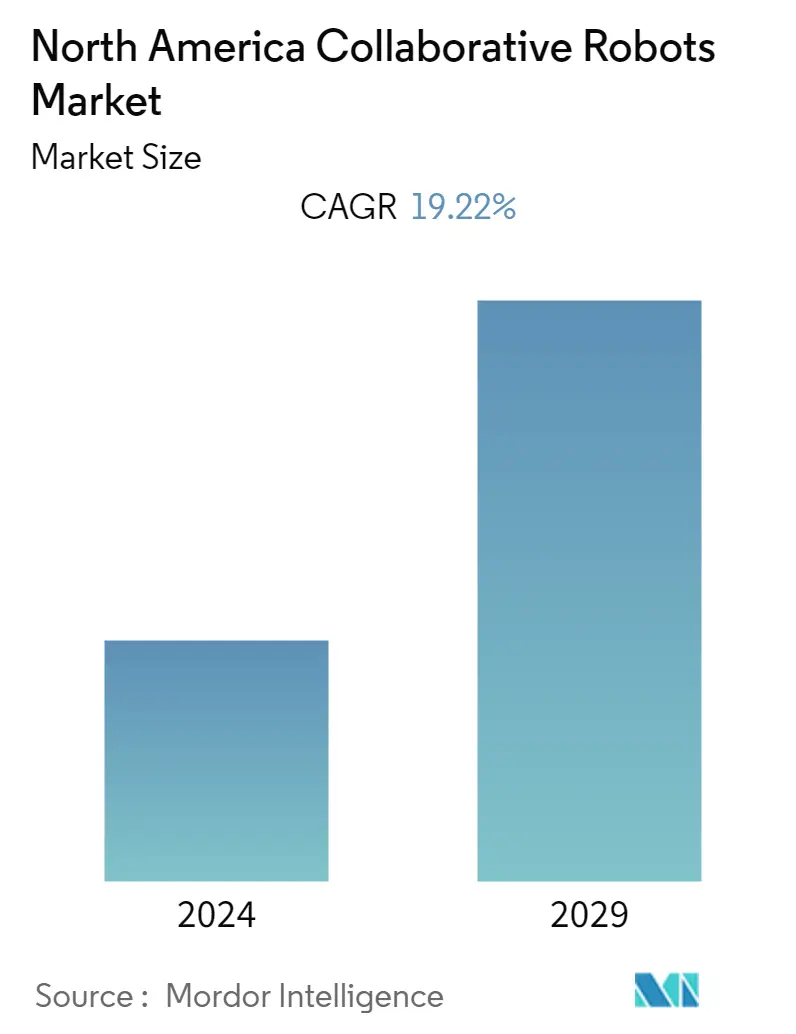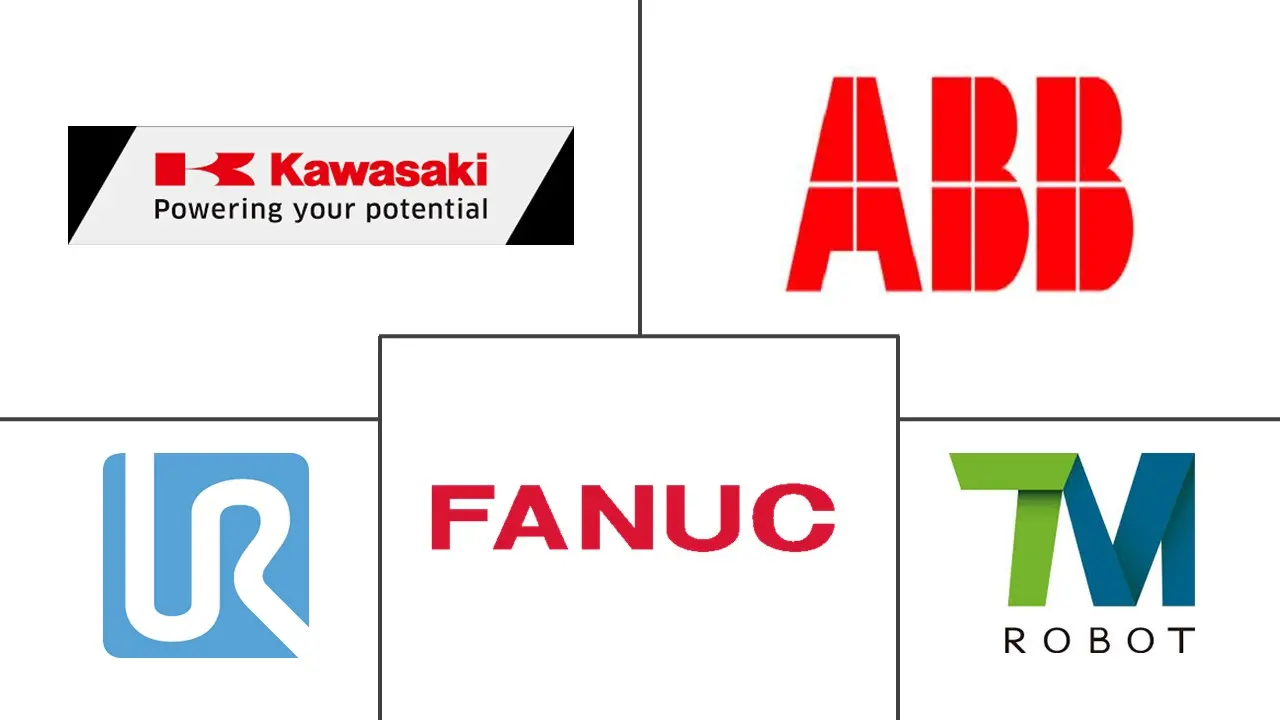Market Size of North America Collaborative Robots Industry

| Study Period | 2019 - 2029 |
| Base Year For Estimation | 2023 |
| Forecast Data Period | 2024 - 2029 |
| Historical Data Period | 2019 - 2022 |
| CAGR | 19.22 % |
| Market Concentration | Medium |
Major Players
*Disclaimer: Major Players sorted in no particular order |
North America Collaborative Robots Market Analysis
The North America Collaborative Robots Market is expected to reach a CAGR of 19.22% during the forecast period (2021 - 2026). The COVID-19 outbreak and the lockdown restriction imposed in North America have affected capital investments and industrial activities across the region. Following the global economic recession led by COVID-19, the collaborative robot market in North America also has witnessed a mixed impact in Q1 2020. Most enterprises operating in the end-user industries (majorly manufacturing, automotive) had shuttered down their production sites due to lockdown restrictions.
- As the region is continuously fighting the rapid spread of the COVID-19 pandemic, robotics and automation play a crucial role in safeguarding the people and processing the supplies that people need as they are shifting toward remote working and home learning. Automation is considered to be on the front lines in the battle against the pandemic. The robots are helping in disinfecting the hospitals. Autonomous deliveries from the robots are bringing supplies to people as they are adopting social distancing. Moreover, automated workstations are speeding up the work of pharmaceutical companies.
- Moreover, Canada is witnessing the significant deployment of collaborative robots in its industrial sector, especially in the automotive sector. For instance, collaborative robots are being employed by global companies, such as Magna International Inc. and Linamar Corp., where they perform tasks, such as visual inspection of parts or picking out components on an assembly line, tasks that might be boring to humans but until now were far too complex for machines.
- Furthermore, Universal Robots conducted America's largest virtual collaborative robot expo and conference in July 2020. The company said that it is witnessing an uptick in the interest for collaborative robots by multiple clients, owing to the social distancing requirements, reshoring to avoid long supply chains and the need for rapid production line change-overs, thus showcasing how these collaborative robots can play a crucial role in helping manufacturers successfully navigate through the COVID-19 pandemic.
- Moreover, in January 2020, FANUC America, one of the prominent suppliers of robotics, CNCs, Robomachines, and Industrial IoT solutions, demonstrated the new DR-3iB food-grade delta robot and the M-410iC/110 palletizing robot at the International Production and Processing Expo (IPPE) held in January 2020. The company's new DR-3iB/8L food-grade delta robot primarily uses 2D iRVision and iRPickTool line tracking software to pick randomly oriented packages of chicken from a continuous infeed conveyor. The robot is also equipped with a multi-pick gripper that can pick up three packages and place them into a box on a fixed outfeed station to simulate case packing.
North America Collaborative Robots Industry Segmentation
Collaborative robots are designed to work with humans, and they are built with safety features, such as integrated sensors, passive compliance, and overcurrent detection. The integrated sensors feel external forces, and if the force is too high, they halt the robot's movement.
This report covers the market's detailed segmentation by different payloads used for multiple applications, such as pick and place, assembling, and material handling. The report covers multiple end-user industries, such as automotive, food and beverages, electronics, logistics, and chemical and pharmaceuticals.
The market value provided is for Y-o-Y revenue incurred in the collaborative robot (instead of the total market valuation). The report also covers the impact of COVID-19 on the collaborative robot market.
| By Payload | |
| Less than 5 kg | |
| 5-9 kg | |
| 10 kg and Above |
| By End-user Industry | |
| Electronics/Semiconductor & FPD | |
| Automotive | |
| Other End-user Industries |
| By Application | |
| Material Handling | |
| Pick and Place | |
| Assembly | |
| Other Applications (Palletizing/De-palletizing, Welding, Painting, Sorting, Positioning, etc.) |
North America Collaborative Robots Market Size Summary
The North America Collaborative Robots Market is experiencing significant growth, driven by the increasing adoption of robotics across various industries. The region is a leader in innovation and adoption of collaborative robots, with a strong focus on manufacturing, automotive, and healthcare sectors. The COVID-19 pandemic has accelerated the need for automation, as robots play a crucial role in maintaining operations while adhering to social distancing measures. The demand for collaborative robots is further fueled by the need for rapid production line changes and the reshoring of supply chains. Companies like Universal Robots and FANUC America are at the forefront, showcasing advanced robotic solutions that enhance productivity and efficiency in industrial operations.
The market is characterized by a high level of competition, with numerous companies vying for market share through strategic initiatives such as new product launches and collaborations. The United States, in particular, is witnessing a surge in the adoption of robotic surgery and industrial automation, supported by government initiatives like the National Robotics Initiative. The collaborative robots are increasingly being integrated into smart factories, enhancing productivity and operational efficiency. As the market continues to evolve, technological advancements are enabling robots to handle more complex tasks, further expanding their application across sectors such as e-commerce, food processing, and material handling.
North America Collaborative Robots Market Size - Table of Contents
-
1. MARKET INSIGHTS
-
1.1 Market Overview
-
1.2 Industry Attractiveness -Porter's Five Forces Analysis
-
1.2.1 Bargaining Power of Suppliers
-
1.2.2 Bargaining Power of Consumers
-
1.2.3 Threat of New Entrants
-
1.2.4 Intensity of Competitive Rivalry
-
1.2.5 Threat of Substitute Products
-
-
1.3 Industry Value Chain Analysis
-
1.4 Impact of COVID-19 on the Market
-
1.5 Market Drivers
-
1.5.1 High Return on Investment and Advancements in Edge Computing Leading to Easier Implementation
-
1.5.2 Increasing Demand for Automation in Various Industrial Processes
-
-
1.6 Market Challenges
-
-
2. MARKET SEGMENTATION
-
2.1 By Payload
-
2.1.1 Less than 5 kg
-
2.1.2 5-9 kg
-
2.1.3 10 kg and Above
-
-
2.2 By End-user Industry
-
2.2.1 Electronics/Semiconductor & FPD
-
2.2.2 Automotive
-
2.2.3 Other End-user Industries
-
-
2.3 By Application
-
2.3.1 Material Handling
-
2.3.2 Pick and Place
-
2.3.3 Assembly
-
2.3.4 Other Applications (Palletizing/De-palletizing, Welding, Painting, Sorting, Positioning, etc.)
-
-
North America Collaborative Robots Market Size FAQs
What is the current North America Collaborative Robots Market size?
The North America Collaborative Robots Market is projected to register a CAGR of 19.22% during the forecast period (2024-2029)
Who are the key players in North America Collaborative Robots Market?
Universal Robots AS, Fanuc Corp., TechManRobot Inc., ABB LTD and Kawasaki Heavy Industries Ltd are the major companies operating in the North America Collaborative Robots Market.

